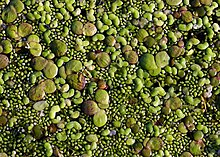New tone

Neuston (Greek neuston "the swimming one") describes the entirety of the organisms that live in a thin layer directly under the surface of the water. Sometimes a layer about five centimeters thick is assumed, in other cases only a layer a few millimeters thick is considered.
Neuston habitat
Very special conditions prevail directly on or below the surface of the water to which animals have to be adapted in order to survive here. For example, the proportion of harmful ultraviolet radiation is high, and it is assumed that the blue or violet colorations that often appear in new tones represent a radiation protection. Temperature and salinity are very variable in the course of the day, and strong waves occur during storms. In addition, Neuston species are exposed to predators both from the water and from the air, which is why they often experience the phenomenon of so-called countershading (different colors on the top and bottom). A special form of the new clay is the Epineuston , which only includes organisms that live directly on the water surface. One example is the water strider.
Often the species grouped together as Pleuston are added to the Neuston, as it is difficult to separate the two groups.
Subdivision of the new tone
After the shift:
- Epineuston: organisms that live on the surface film of the water, such as water striders and whirligig beetles
- Hyponeuston: Organisms that live directly under the surface film of water
According to the composition:
- Anemone Clay: terrigenic organic and inorganic material that was carried to the surface of the water by the wind
- Bacterioneuston: the bacterial inhabitants of the new clay
- Ichthyone Clay: fish or their freely swimming eggs or larvae in the new clay
- Phytoneuston: plant organisms in the new clay
See also
Web links
- DW-TV , August 14, 2020: Plastic waste in the sea: Are safety nets destroying one of the ocean's most puzzling ecosystems?
- Merry Youle, schaechter.asmblog.org: Of Terms in Biology: Neuston (English)
- wordinfo.info: neusto-, neust-, -neuston, -neustonic (English)
swell
- Michael Cunliffe and J Colin Murrell: The sea-surface microlayer is a gelatinous biofilm. In: The ISME Journal. 3, 2009, pp. 1001–1003 (English, Open Access)
- MP Franklin, IR McDonald, DG Bourne, NJ Owens, RC Upstill-Goddard, JC Murrell: Bacterial diversity in the bacterioneuston (sea surface microlayer): the bacterioneuston through the looking glass. In: Environmental microbiology. Volume 7, Number 5, May 2005, pp. 723-736, doi : 10.1111 / j.1462-2920.2004.00736.x , PMID 15819854 .
- John T. Hardy: Phytoneuston ecology of a temperate marine lagoon. In: Limnology and Oceanography. Volume 18, number 4, July 1973, pp. 525–533, doi : 10.4319 / lo.1973.18.4.0525 (English, Open Access)